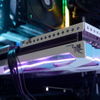Graphics card temperatures
Graphics card temperatures
So here we’ll have a look at GPU temperatures.
First up will be IDLE (desktop) temperatures as reported through the software on the thermal sensors of the GPU.
Anything below 50 Degrees C is considered okay; anything below 40 Degrees C is admirable. But what happens when we are gaming? We fire off an intense game-like application at the graphics card and measure the highest temperature of the GPU.
So with the card fully stressed, we kept monitoring temperatures and noted down the GPU temperature as reported by the thermal sensor. These tests have been performed at a 21~22 Degrees C room temperature, a peak temperature based on a GPU stress loop.
One important note – the review is not directly comparable to Hilbert’s, as the conditions, hardware, and equipment are different; for example, the test is made in the chassis, not on the test bench, which influences the temperatures. Also, the other GPUs included in the charts are the ones I own, and can check.
Extended Duration Stress Temperature and GPU Throttling clock
Always, before beginning benchmarking, the card is preheated. We monitor the GPU throttle’s dynamic clock once the GPU has warmed up, which is around ~2610 MHz (so the standard GPU Boost Clock), and we see this during the repeated warm-up phase of at least 15 minutes of GPU gaming stress. We do this before every evaluation because a cold card could perform better in the first few seconds of a benchmark.





